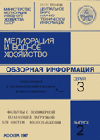Russian Federation
VAK Russia 06.01.2002
VAK Russia 06.01.2004
UDC 63
CSCSTI 68.05
CSCSTI 68.31
CSCSTI 68.33
Russian Classification of Professions by Education 06.04.02
Russian Classification of Professions by Education 06.03.02
Russian Classification of Professions by Education 110000
Russian Classification of Professions by Education 35.03.03
Russian Classification of Professions by Education 35.04.03
Russian Library and Bibliographic Classification 40
Russian Trade and Bibliographic Classification 5605
Russian Trade and Bibliographic Classification 5607
BISAC TEC003000 Agriculture / General
BISAC TEC003060 Agriculture / Agronomy / Soil Science
The smallest moisture capacity in medium-thick peat soil in a meter layer is 671,2 mm, which is 19,3 % more than that of low-power and 38,9 % peat-gley soil. During the formation of the first mowing of perennial grasses, the moisture reserves in the 0,5‑meter layer were always in the optimal range (0,7–0,9 HB). The lack of moisture during deep occurrence of groundwater (1,2–1,6 m) causes a decrease in the yield of the second mowing of perennial grasses by 46–89 % in peat-gley soil and 25–40 % in medium-power soil. The arable layer of peaty-gley soil contains 4,4 times more nitrates than the average power. Without fertilizing after 3 years, the amount of nitrate nitrogen in peaty-gley soil is reduced by 1,9 times, low- and medium-power soil – by 2,3–2,4 times. The amount of nitrate nitrogen is more than that of ammonia, in peat-gley soil 4 times, low-power – 3,5 times. Reserves of available phosphorus in the arable layer of peaty-gley soil are 2,5 times greater than in lowpower, and 3,1 times in average power. Without fertilizing after 4 years, in the arable layer of peaty-gley soil under perennial grasses, the content of available phosphorus decreased by 45,4 %, in low-power – by 20,5 %, in medium-power – by 15,8 %. The advantage in potassium reserves in the arable layer belongs to peaty-gley soil and is due to its high content in the underlying mineral peat. In peaty-gley soil, the decrease in potassium reserves down the profile is 1,6 times; in thin soil – 3,2 times; average power – 2,5 times. Hay productivity of perennial grasses on peaty-gleyic soil is respectively higher by 8.3 and 24,5 % than on low- and medium-power peaty soils. A crucial role in increasing the yield of herbs and gaining increases is played by the nutritional regime.
fertility, peat soil, moisture, nutrients
1. Lukin S.M. Peat soils and drained swamps of Russia: ecological functions, use in Siberian agricultural production and modernization of agribusiness. - Novosibirsk: GNU SibNSKHB, 2012. S. 43-54.
2. Report on the environmental situation in the Tyumen region in 2015. Tyumen: Government of the Tyumen region, 2015. S. 58-65.
3. Prospects for the development of land reclamation in Russia. M.: FSBEI HPE MGUP, 2011. 54 p.
4. Inisheva L.I. Eutrophic bog, characteristic and hydrothermal regime // Innovative technologies in land reclamation. M.: VNIIA Publishing House, 2011. S. 394-398.
5. Motorin A.S. Scientific principles of land reclamation and the use of drained peat soils in Western Siberia // Soil fertility and assessment of agricultural productivity. Tyumen: GAU of the Northern Trans-Urals, 2018. P. 100-112.
6. Motorin A.S. Efficiency of mineral fertilizers on peat soils of the Northern Trans-Urals // Siberian Bulletin S.- kh. Sciences. 2018. No. 5. P. 14-22.
7. Novokhatin V.V. Land reclamation of wetland landscapes of Western Siberia. Tyumen: Publishing house of TSU, 2008. 200 p.









